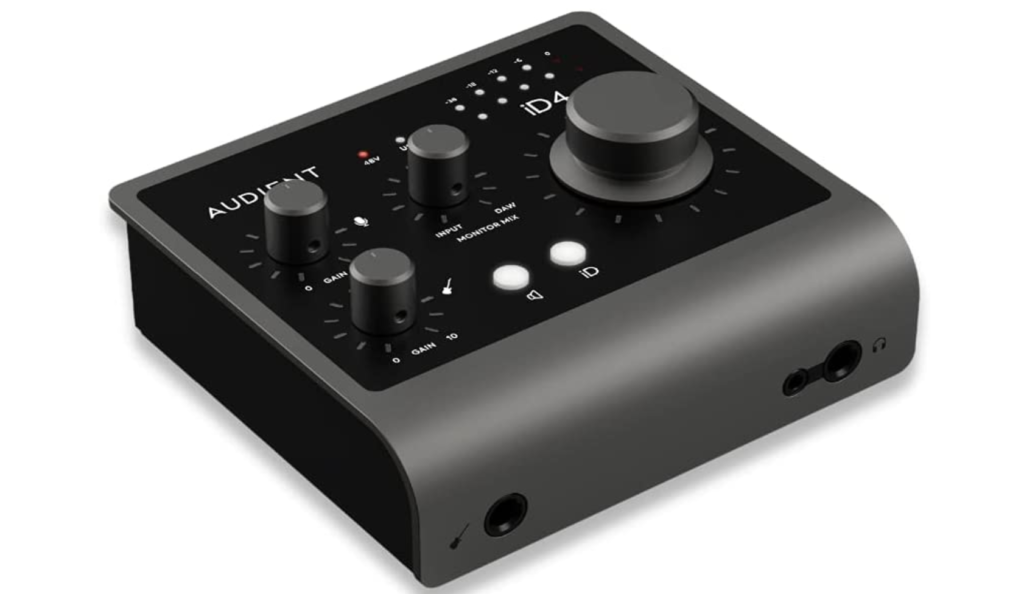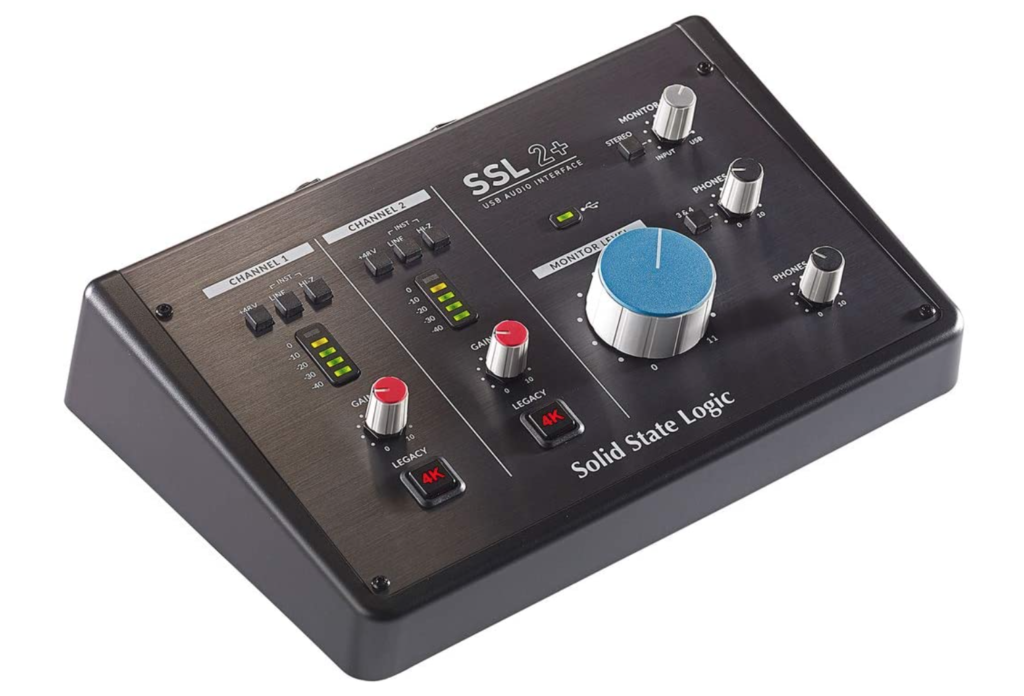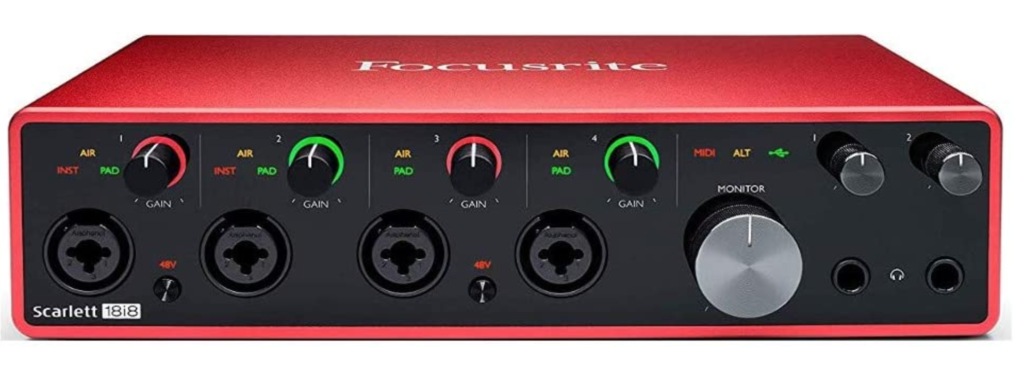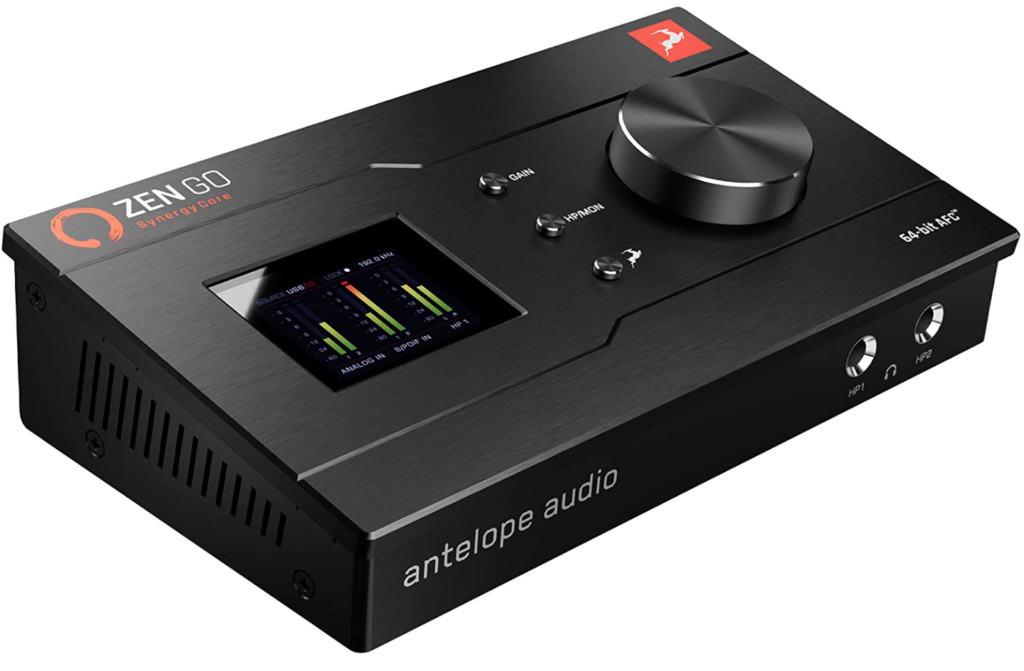Having an audio interface with two headphone jacks is a game-changer.
Have you ever tried to record someone in your studio and wondered how to connect two sets of headphones?
A dual headphone output interface will do the trick. It’ll allow you to connect a set of headphones for monitoring and another for the person recording.
While you’re more likely to find dual outputs in high-end audio interfaces, you’ll also find them in several affordable units.
To save you some time, we’ve compiled a list of the six best audio interfaces with two headphone jacks.
We also provide a brief overview of each to help you decide if it’s a good choice.
Overview: 6 Dual Headphone Output Audio Interfaces
- Audient iD4
- Solid State Logic SSL 2+
- Steinberg UR44C
- PreSonus Studio 24c
- Focusrite Scarlett 18i8
- Antelope Audio Zen Go Synergy Core
Why Use an Audio Interface with Two Headphone Jacks?
If you’re looking to evolve your solo home studio into a place where you can collaborate with other creators, upgrading your audio interface is a great way to start.
Of course, you have your audio interfaces that companies design more for solo use. Most entry-level interfaces fall in this category and have one headphone jack.
However, if you’ve ever recorded someone in your studio, you know how important it is for each person to have their own set of headphones.
The best way to ensure that unnecessary noise doesn’t bleed into your recordings is by having one set of headphones for the engineer and another for the vocalist.
This way, you can maintain a quiet recording environment and monitor the session.
While this concept seems pretty straightforward, many audio interfaces don’t support dual headphone connections.
Below is a list of six high-quality interfaces we recommend that do.
6 Best Audio Interfaces with Two Headphone Outputs
Under $200
1. Audient iD4 (iD14)

The Audient iD4 is arguably the best audio interface under $250.
It’s also the most affordable interface we’ve seen with dual headphone outputs.
Along with dual headphone outputs, you’ll get a combo mic and line input, a ¼-inch JFET instrument input, and two balanced ¼-inch outputs.
Multifunctional Scroll Wheel
At first glance, this interface can seem limited, with only four knobs and two buttons on its top panel.
However, the large knob on the right is a multifunctional scroll wheel. On your average interface, this knob controls the main output volume. But with the iD4, you can also use this knob to adjust plug-in settings and levels in your DAW.
Monitor Mix
This unit also gives you complete control over monitoring with its Monitor Mix feature. This knob lets you blend your zero-latency direct signal (from your inputs) with your computer playback audio.
Here’s how you can use Monitor Mix to reduce latency.
Imagine you’re recording an artist in your studio, and they want to hear effects while recording.
Adding effects can increase latency, but you can blend in your direct signal with the monitor mix feature to minimize it.
You can even set this knob to “input” to record with near-zero latency and no effects.
Audio Quality
We never recommend buying an audio interface just because it has dual headphone outputs.
Ultimately, sound quality and performance are most important.
Luckily, the iD4 excels in these categories.
Here’s a quick overview of everything you need to know about its audio quality:
Audio Resolution
The iD4 has high-resolution 192kHz/24-bit converters. Therefore, you can record and playback audio at 44.1, 48, 88.2, 96, 176.4, and 192kHz sampling rates.
Frequency Response
This unit can record and playback the entire 20Hz – 20kHz human hearing range with a relatively flat frequency response. As a result, your output audio will accurately represent your input audio.
Dynamic Range
It also offers an excellent headroom with a dynamic range (DR) of 113dB.
You won’t have to worry as much about clipping as you would if its dynamic range was in the 90s.
Ultimately, higher DR lets you record hotter signals with less distortion.
Preamps
The iD4 has high-gain, low-noise preamps.
They have a solid gain range of 58dB and an ultra-low equivalent input noise (EIN) of around -130dBu.
Cons
- No clipping indicator
- It doesn’t have dedicated headphone volume controls
- Limited I/O
One feature we would’ve liked to see is a clipping indicator.
Also, to change your headphone volume, you’ll have to select the headphone icon and use the scroll wheel. Adjusting levels is easier when you have dedicated headphone volume controls.
Also, this unit only has enough inputs to record one mic and instrument at a time. Its limited inputs can hold you back in larger recording sessions.
(Alternative) Audient iD14
Luckily, Audient also has the iD14, which offers an insane amount of flexibility at its price.
The iD14 also comes with two headphone jacks.
However, it has two XLR/TRS mic and line inputs, a JFET instrument input, four balanced main outputs, and an ADAT input to expand your inputs up to ten.
It even has individual phantom power controls for each input in case you need to record a condenser and dynamic mic simultaneously.
Other Audient Interfaces with Two Headphone Jacks
Under $300
2. Solid State Logic SSL 2+

The Solid State Log SSL 2+ is most known for its 4K legacy feature. But its dual headphone outputs also make this interface stand out.
Not only does the SSL2+ come with two headphone jacks, but it also dedicated volume controls for each.
SSL2+ vs Audient iD4
Besides features, the main difference between the SSL 2+ and the iD4 is that you’ll have to adjust your headphone volume through the scroll wheel.
At first, controlling different settings through the scroll wheel can take some getting used to.
On the other hand, the SSL 2+ has dedicated volume knobs for each headphone output.
4K Legacy
The most asked about SSL 2+ feature is 4K Legacy.
We explain and rate this feature in our review of the SSL 2.
To summarize, this feature boosts high frequencies and adds harmonic distortion to make your audio sound crisper.
Other Features
Overall, the SSL 2+ is one of the rare, affordable interfaces that give you complete control in your home studio.
It has separate phantom power buttons for each mic input and a Monitor Mix knob that you can control while recording in mono and stereo.
Audio Quality
Audio Resolution
The SSL 2+ features premium 192kHz/24-bit converters allowing you to record at a max sample rate of 192kHz and bit-depth of 24-bits.
Frequency Response
As with most interfaces these days, the SSL 2+ can record and playback the entire 20Hz – 20kHz hearing range with a nearly flat frequency response.
Dynamic Range
This unit provides excellent headroom with a dynamic range of 110dB.
Preamps
The SSL 2+’s preamps offer an impressive 62dB gain range – with an ultra-low EIN of around -131dBu.
Cons
Like the iD4, the SSL 2+ doesn’t have clipping indicators, but this is the only downside we notice.
Under $400
3. Steinberg UR44C

Since we’re such a fan of Steinberg’s UR12 interface, we had to test the UR44. And to no surprise, it doesn’t disappoint.
Steinberg UR44C vs. Solid State Logic SSL 2+
Like the SSL 2+, the UR44C has dual headphone outputs with corresponding volume knobs. However, it has four combo mic inputs and two additional line inputs in the back.
We recommend this unit if you plan on recording a band or connecting multiple line devices like preamps, EQs, or compressors.
DSP Effects
Most notably, the UR44 has built-in DSP effects letting you record with effects without adding latency.
It offers REV-X reverb, Morphing Channel Strip, and Guitar Amp Classics.
You can control these effects through the included Cubase Artist DAW or dspMixFx application.
Additional Flexibility in your Home Studio
Ultimately, the UR44 can give your home studio a significant bump in professionalism.
Its dual headphone outputs, six inputs, and four outputs provide a nice amount of flexibility.
You’ll be prepared for larger recording sessions, particularly if you’re an engineer or running a professional home studio.
Not having enough inputs won’t be a problem if you’re recording a small band.
To top it off, the built-in DSP effects can add flavor to your audio and spice things up in your studio.
Audio Quality
Here’s a quick overview of the Steinberg UR44C’s recording and playback quality.
Audio Resolution
The UR44C features impressive 192kHz/32-bit converters.
Frequency Response
This unit has a relatively flat frequency response between 20Hz – 20kHz.
Therefore, it can accurately record and playback frequencies without altering tones in your audio.
Dynamic Range
The UR44C offers decent headroom with a dynamic range of around 102dBu.
Preamps
You’ll also get a +10 to +54dB gain range which is a tighter window than we would like.
A +44dB range is suitable for condenser mics, but you may need a Cloudlifter or Fethead to supply additional gain to low output dynamic mics.
Cons
Keep in mind that you’ll have to use a multichannel headphone amp if you want to use more than two inputs.
Dual headphone outputs are excellent when it’s just you and another person. But in a group session, you’ll need to connect additional sets of headphones.
We’ll discuss how to connect a headphone amp to your audio interface toward the end.
Steinberg Dual Headphone Output Interfaces
Another Steinberg interface with dual headphone outputs is the UR816C.
Under $500
4. PreSonus Studio 1810c

If you’re familiar with the PreSonus Studio 24c, the 1810c is basically an expanded version.
Unlike the 24c, it comes with two headphone jacks with corresponding volume controls.
PreSonus Studio 1810c vs. Steinberg UR44c
The difference between the PreSonus Studio 1810c and the Steinberg UR44C is the 1810c doesn’t have built-in DSP effects or a monitor mix knob on its front panel.
Instead, you can control your monitor mix using the UC Surface software or Studio One Artist DAW.
I/O
The 1810c comes with four combo mic inputs with four-line inputs on the back.
You’ll also get six ¼-inch outputs, an ADAT input, and S/PDIF I/O to expand its inputs to 18 and outputs to 8.
Audio Quality
The 1810c delivers impressive audio quality. Here are a few things to know.
Audio Resolution and Frequency Response
Sample rate: 192kHz
Bit-depth: 24-bits
Frequency Response: Relatively flat between 20Hz – 20kHz
Dynamic Range and Preamps
The 1810c offers an excellent 114dB dynamic range giving you plenty of headroom.
Additionally, its preamps have a -15 to +65dB gain range. This wide range is great when working with instruments with different output levels – and +65 dB is a nice amount of gain for low output dynamic mics.
Cons
The Studio 1810c doesn’t have a Monitor Mix knob on its front panel.
Instead, you’ll have to adjust your monitor mix through your computer, which is slightly less convenient.
Dual Headphone Output PreSonus Audio Interfaces
The PreSonus 1824c is another PreSonus audio Interface with two headphone jacks.
5. Focusrite Scarlett 18i8 3rd Gen

The Focusrite Scarlett 2i2 is one of the most sought-after entry-level interfaces. If you’re a fan of the 2i2 but want more versatility, we recommend the Focusrite Scarlett 18i8.
The Scarlett 18i8 offers two headphone jacks with individual volume controls, four mic/line inputs, four additional line inputs, two instrument inputs, and an ADAT input, allowing you to add eight more channels.
Focusrite Scarlett 18i8 vs PreSonus Studio 1810c
The Focusrite 18i8 has a cleaner layout than the PreSonus 1810c.
However, it doesn’t come with LED meters like you’ll find on the 1810c.
Instead, you’ll get halo gain indicators. These indicators will tell you if your signal is at a good level of clipping. But it isn’t as helpful for setting gain as the Studio 1810c’s level meters.
Air Mode
The Air Mode feature modeled after Focusrite’s ISA mic preamp sets Focusrite Scarlett interfaces apart.
Air Mode boosts high frequencies in your audio to make it sound brighter and more open.
Usually, you would need to purchase an external tube preamp for this effect. Check out our review of the Focusrite Scarlett 2i2 to learn more about Air Mode.
Monitor Mix and Audio Loopback
The Focusrite Control software lets you control the Monitor Mix and Loopback features.
Audio Loopback records your mics and computer’s audio on separate channels giving you more control during post-production.
But when is Audio Loopback a helpful feature?
You can use Loopback to record audio from your outputs while recording your voice through your mic when you’re recording/streaming yourself producing or mixing.
Audio Quality
Here are some quick points about the Scarlett 18i8’s audio quality.
Audio Resolution and Frequency Response
- Maximum Sample Rate: 192kHz
- Bit Depth: 24-Bits
- Frequency Response: Fairly flat between 20Hz – 20kHz
Dynamic Range and Preamps
- Dynamic Range: 110dB
- Preamp Gain Range: 56dB
- Preamp EIN: -128dBu
Other Focusrite Audio Interfaces with Two Headphone Jacks
Under 600
6. Antelope Audio Zen Go Synergy Core

In a recent post, we listed the Antelope Audio Zen Q as the audio interface with the best preamps.
However, this interface goes for almost $1,000.
While it’s worth every penny, we recommend the more affordable AA Zen Go Synergy Core if you’re on a budget.
It’s a 4-in, 8-out interface with two combo mic/line/instrument inputs, two ¼-inch, two RCA outputs, and a S/PDIF I/O to add more channels.
Antelope Audio Zen Go Synergy Core vs. Focusrite Scarlett 18i8
Since it’s on this list, you know it has dual headphone jacks. But its built-in DSP effects are separated from the Antelope Audio Zen Go from the Focusrite Scarlett 18i8.
DSP effects are like the mixing plug-ins in your DAW, except they’re programmed into your interface. Therefore, you can record with effects without adding latency.
The Zen Go’s DSP library features 37 effects, including EQs, compressors, reverb, mic preamps, and guitar amps. You also have the option to expand this library by 50 effects if you like what you hear.
Antelope Audio includes an easy-to-use software Control Panel where you can adjust these effects, your monitor mix, Loopback feature, and volumes.
Recording quality
Cons
As with a few interfaces on the list, the Zen Go doesn’t have dedicated volume controls for each headphone output.
Instead, you can adjust your headphone volume through the Control Panel.
Other Antelope Audio Interfaces with Two Headphone Jacks:
How to Expand your Headphone Outputs with a Headphone Amp
Another way to expand your headphone outputs is using a multichannel amplifier.
Headphone amps serve multiple purposes. You can use them to drive high impedance headphones, but they can also provide additional headphone outputs.
Check out this post for two easy ways to connect a headphone amp to your audio interface.
Best 3 Headphone Amps
4 Outputs
16 Outputs
When Do you Need More than Two Headphone Outputs?
We’ve mentioned a few interfaces with more than two outputs in this list.
In these cases, having more than two headphone outputs is better. This way, you can have a set of earphones for each input.








